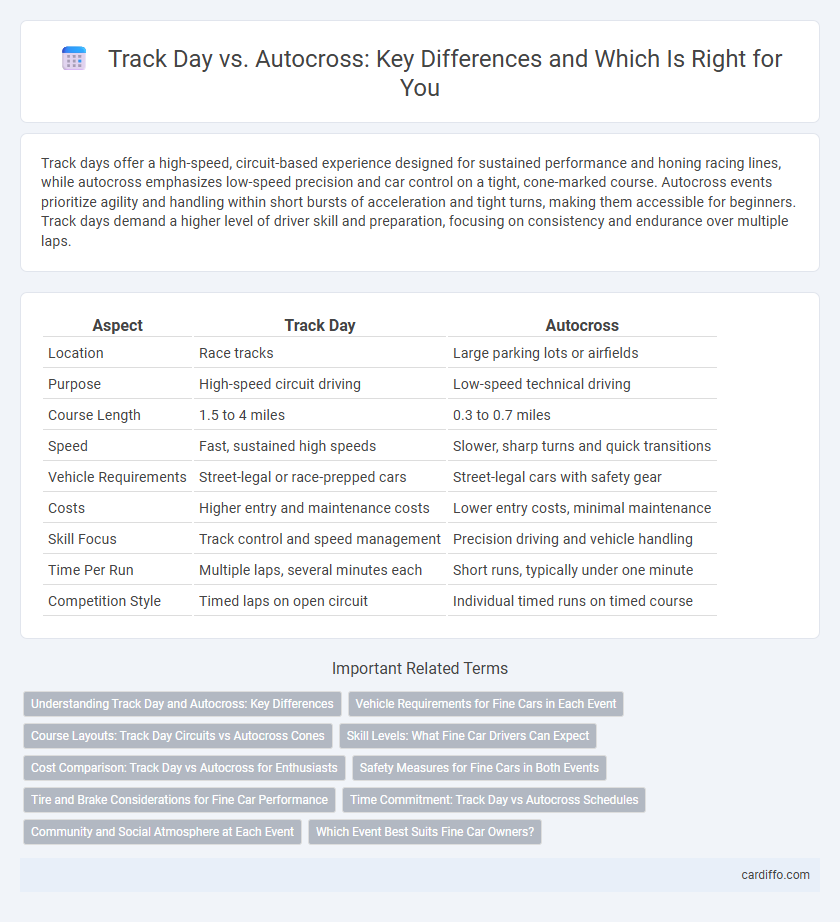Track days offer a high-speed, circuit-based experience designed for sustained performance and honing racing lines, while autocross emphasizes low-speed precision and car control on a tight, cone-marked course. Autocross events prioritize agility and handling within short bursts of acceleration and tight turns, making them accessible for beginners. Track days demand a higher level of driver skill and preparation, focusing on consistency and endurance over multiple laps.
Table of Comparison
| Aspect | Track Day | Autocross |
|---|---|---|
| Location | Race tracks | Large parking lots or airfields |
| Purpose | High-speed circuit driving | Low-speed technical driving |
| Course Length | 1.5 to 4 miles | 0.3 to 0.7 miles |
| Speed | Fast, sustained high speeds | Slower, sharp turns and quick transitions |
| Vehicle Requirements | Street-legal or race-prepped cars | Street-legal cars with safety gear |
| Costs | Higher entry and maintenance costs | Lower entry costs, minimal maintenance |
| Skill Focus | Track control and speed management | Precision driving and vehicle handling |
| Time Per Run | Multiple laps, several minutes each | Short runs, typically under one minute |
| Competition Style | Timed laps on open circuit | Individual timed runs on timed course |
Understanding Track Day and Autocross: Key Differences
Track day events take place on closed circuit race tracks, allowing drivers to experience high speeds and practice advanced driving skills under controlled conditions. Autocross involves navigating a timed course defined by cones on a large paved area, emphasizing precision, vehicle handling, and quick reflexes over outright speed. Understanding these distinctions helps drivers choose the event that best matches their skill level and performance goals.
Vehicle Requirements for Fine Cars in Each Event
Track day events typically demand vehicles with robust braking systems, enhanced cooling, and high-performance tires to sustain prolonged high-speed driving. Autocross cars prioritize agility, requiring lightweight construction, responsive suspension setups, and quick steering for tight cornering and rapid acceleration. Fine cars in track days often feature upgraded aerodynamic components, while autocross vehicles emphasize maneuverability and immediate power delivery.
Course Layouts: Track Day Circuits vs Autocross Cones
Track day circuits feature extensive layouts with a combination of high-speed straights, sweeping corners, and technical sections designed to test a car's overall performance and driver skill. Autocross courses use tightly spaced cones to create short, twisty, and technical paths emphasizing precision and handling over outright speed. The differing course designs influence vehicle setup and driving techniques, with track days favoring aerodynamic stability and autocross demanding agile maneuverability.
Skill Levels: What Fine Car Drivers Can Expect
Fine car drivers can expect track days to demand advanced skills such as high-speed cornering, consistent braking, and precise throttle control on longer, complex circuits. Autocross events emphasize sharp handling, quick reflexes, and rapid transitions through tight cones on short, technical courses, making them ideal for honing vehicle control and reaction times. Both settings offer valuable skill development, with track days enhancing high-speed stability and autocross improving agility and precision.
Cost Comparison: Track Day vs Autocross for Enthusiasts
Track days typically incur higher costs due to extended track time, advanced safety requirements, and potential vehicle modifications, often ranging from $200 to $400 per session. Autocross events are more budget-friendly, with entry fees usually between $30 and $60, minimal vehicle wear, and lower equipment expenses, making it accessible for enthusiasts seeking competitive driving without significant financial investment. Overall, autocross offers a cost-effective option for skill improvement, while track days provide a more immersive but pricier racing experience.
Safety Measures for Fine Cars in Both Events
Track days and autocross events both demand rigorous safety measures to protect fine cars and their drivers. Mandatory use of helmets, roll cages, and fire-resistant suits ensures occupant safety while reinforced brake systems and tire checks prevent mechanical failures. Strict adherence to track regulations and proper vehicle inspection reduces risks, making both events safer for high-performance vehicles.
Tire and Brake Considerations for Fine Car Performance
Tire selection for track day events emphasizes high-grip, heat-resistant compounds that maintain performance over sustained laps, while autocross demands tires with quick warm-up times and superior lateral grip for short, intense bursts. Brake components for track days require robust cooling solutions and durable materials to withstand prolonged high temperatures, contrasting with autocross brakes that focus on rapid response and minimal fade during frequent, sharp stops. Optimizing tire and brake setups tailored to each discipline enhances overall fine car performance by maximizing grip, control, and durability under specific stress conditions.
Time Commitment: Track Day vs Autocross Schedules
Track days typically require a full day commitment, often lasting 4 to 8 hours with multiple sessions, demanding more extensive preparation and recovery time. Autocross events usually span only a few hours, often an afternoon or evening, making them more accessible for participants with limited free time. Scheduling flexibility favors autocross, with frequent local events, while track days are less frequent and often scheduled at larger venues.
Community and Social Atmosphere at Each Event
Track days foster a tight-knit community of enthusiasts who share a passion for high-speed driving, creating an environment rich in camaraderie and knowledge exchange. Autocross events emphasize accessibility and friendly competition, encouraging participants of all skill levels to connect and support each other in a more informal setting. Both atmospheres promote social interaction, but track days often attract dedicated racers, while autocross appeals to a broader, diverse group of automotive hobbyists.
Which Event Best Suits Fine Car Owners?
Track days provide fine car owners with a controlled environment to fully explore their vehicle's high-performance capabilities on a smooth, timed circuit, emphasizing speed and precision. Autocross events offer a more accessible and technical experience, focusing on tight turns and agility in a safe, low-speed setup that minimizes wear and risk to valuable fine cars. Owners seeking maximum thrill and skill development typically prefer track days, while those prioritizing car preservation and driver technique often choose autocross.
Track day vs Autocross Infographic

 cardiffo.com
cardiffo.com